Carlo Crivelli (1435 – 1495)
Get a Crivelli Certificate of Authenticity for your painting (COA) for your Crivelli drawing.
For all your Crivelli artworks you need a Certificate of Authenticity (COA) in order to sell, to insure or to donate for a tax deduction.
Getting a Crivelli Certificate of Authenticity (COA) is easy. Just send us photos and dimensions and tell us what you know about the origin or history of your Crivelli painting or drawing.
If you want to sell your Crivelli painting or drawing use our selling services. We offer Crivelli selling help, selling advice, private treaty sales and full brokerage.
We have been authenticating Crivelli and issuing certificates of authenticity since 2002. We are recognized Crivelli experts and Crivelli certified appraisers. We issue COAs and appraisals for all Crivelli artworks.
Our Crivelli paintings and drawings authentications are accepted and respected worldwide.
Each COA is backed by in-depth research and analysis authentication reports.
The Crivelli certificates of authenticity we issue are based on solid, reliable and fully referenced art investigations, authentication research, analytical work and forensic studies.
We are available to examine your Crivelli painting or drawing anywhere in the world.
You will generally receive your certificates of authenticity and authentication report within two weeks. Some complicated cases with difficult to research Crivelli paintings or drawings take longer.
Our clients include Crivelli collectors, investors, tax authorities, insurance adjusters, appraisers, valuers, auctioneers, Federal agencies and many law firms.
We perform Carlo Crivelli art authentication, appraisal, certificates of authenticity (COA), analysis, research, scientific tests, full art authentications. We will help you sell your Carlo Crivelli or we will sell it for you.
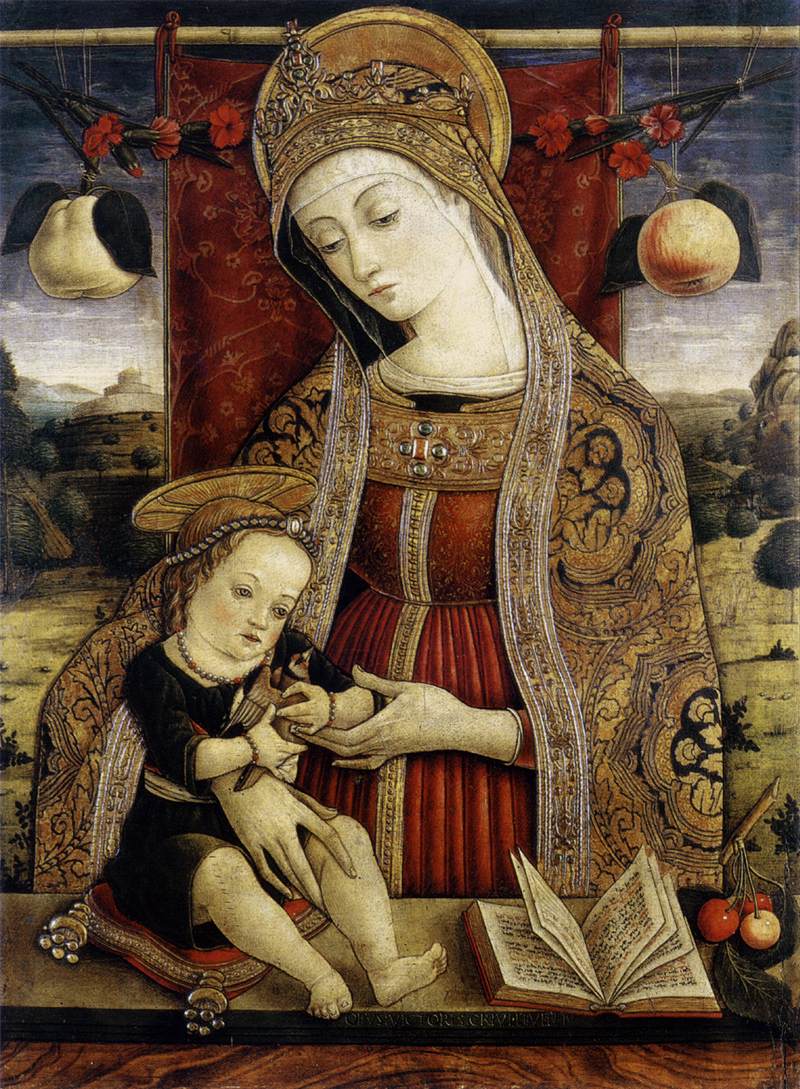
Madonna and Child 1482
Carlo Crivelli was a Venetian Renaissance or Quattrocento painter. Crivelli was born around 1435 in Venice. The only dates that can with certainty be given about his life as a painter are 1468 and 1493: these are, respectively, the earliest and the latest years signed on his pictures–the former on an altar-piece in the church of San Silvestro at Massa near Fermo, and the latter on a picture in the Oggioni collection in Milan.

St. Michael 1476
Though born in Venice, Crivelli seems to have worked chiefly in Le Marche of Ancona, and especially in and near Ascoli; there are only two pictures in Venice, in the church of San Sebastiano. He is said to have studied under Jacobello del Fiore, who was painting as late at any rate as 1436; at that time Crivelli was probably only a boy. He also studied at the school of Vivarini in Venice, then left Venice, initially, it is generally believed, for Padua, where he is believed to have worked in the workshop of Francesco Squarcione and then for Zara in Dalmatia (now part of Croatia, but then a Venetian territory) in 1459, following legal trouble after he was sentenced to prison for six months for having an affair with a married woman, Tarsia Cortese, the wife of a sailor.
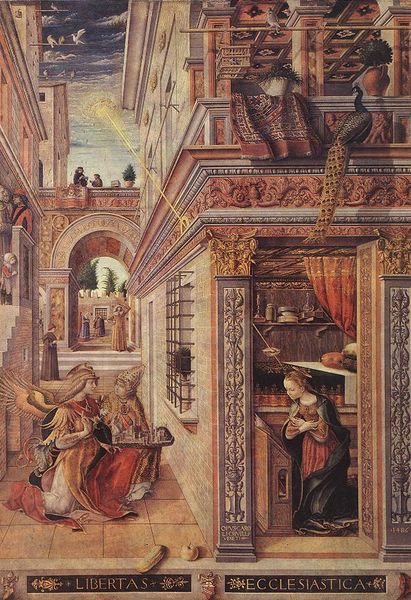
Annunciation 1486
The artist always signed himself by a variant of “Carlo Crivelli of Venice, e.g. Carolus Crivellus Venetus; from 1490 he added the title “Miles”, by then having been knighted (Cavaliere) by Ferdinand II of Naples. He painted in tempera only, despite the increasing popularity of oil painting during his life-time. Unlike the naturalistic trends arising from Florence at the same time, Crivelli’s style still echoes the Byzantine sensibility. The urban settings are jewel-like, and full of elaborate allegorical detail.

Madonna Enthroned 1475
He introduced agreeable landscape backgrounds, and was particularly partial to giving fruits and flowers as accessories, often in pendant festoons, which are a characteristic of the Paduan studio of Francesco Squarcione, where Crivelli may have worked. The National Gallery, London is well supplied with examples of Crivelli; the Annunciation with St Emidius, possibly his most famous painting, and the Beato Ferretti (of the same family as Pope Pius IX) in religious ecstasy, may be specified. Another of his principal pictures is in San Francesco di Matelica; in Berlin is a Madonna and Saints (1491); in the Vatican Gallery a Dead Christ, and in the Brera of Milan the Madonna of the Candle. There are also examples of his work in several major US galleries.
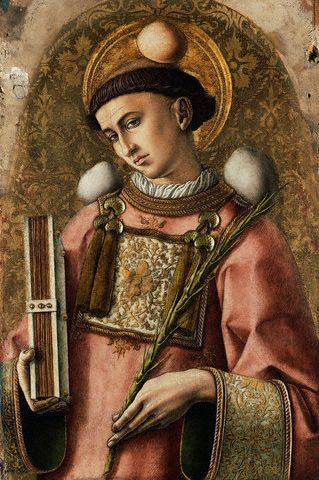
Saint Stephen 1476
Despite his Venetian birth, his paintings have a linear Umbrian quality. Crivelli is a painter of marked individuality; unlike Giovanni Bellini, his contemporary, his works are not “soft”, but are clear and definite in contour and with an astounding attention to detail. His use of “trompe l’oeil,” often compared to painters of the Northern Renaissance such as Rogier van der Weyden, includes raised objects, such as tears and “jewels” made of gesso. Commissioned by the Franciscans and Dominicans of Ascoli, Crivelli’s work is exclusively religious in nature. His paintings consist largely of Madonna and Child images, Pietas, and the by-then-old-fashioned altarpiece known as the polyptych. Often filled with images of suffering, such as gaping wounds in Christ’s hands and side and the mouths of mourners twisted in agony, Crivelli’s work appropriately fulfills the spiritual needs of his patrons. These ultra-realistic, sometimes disturbing, qualities have often led critics to label Crivelli’s paintings “grotesque,” much like his fellow Northern Italian painter, Cosimo Tura.
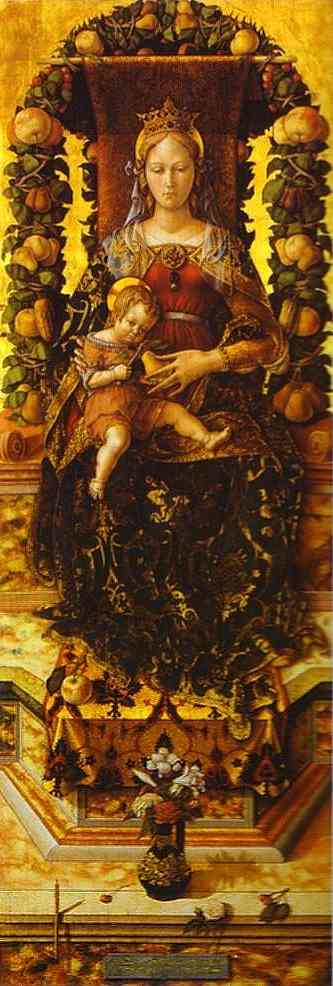
Madonna of the Taper 1490
Few artists seem to have worked with more uniformity of purpose, or more forthright command of his materials and this was recognized by the number of prestigious commissions he was awarded. It is possible that Carlo was of the same family as the painters as Donato Crivelli (who was working in 1459, and was also a scholar of Jacobello) – Vittorio Crivelli, with whom he occasionally collaborated, was his younger brother. Pietro Alemanno, a painter who had traveled to Le Marche from Germany/Austria) was his pupil/collaborator.
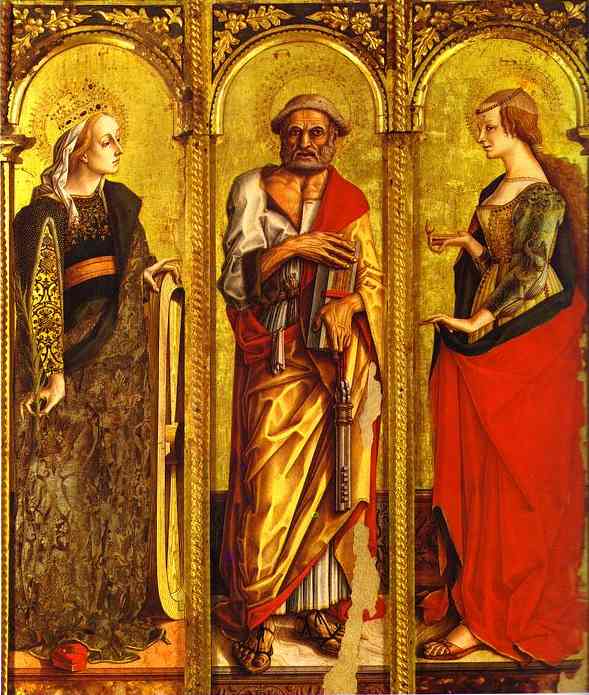
St. Catherine of Alexandria, St. Peter and Mary Magdalene, 1475
Carlo Crivelli died in the Marche (probably Ascoli Piceno) around 1495. His work fell out of favor following his death and he is not mentioned in Vasari’s Lives of the Artists (which is notably Florence-centric). He had something of a revival, especially in the UK, during the time of the pre-Raphaelite painters, several of whom, including Edward Burne-Jones were admirers of Crivelli. Admiration for his work declined with the decline of the pre-Raphaelites during the Modernist period, but recent writings on his work and a re-hanging of his work in the National Gallery, London, are again bringing him more attention.
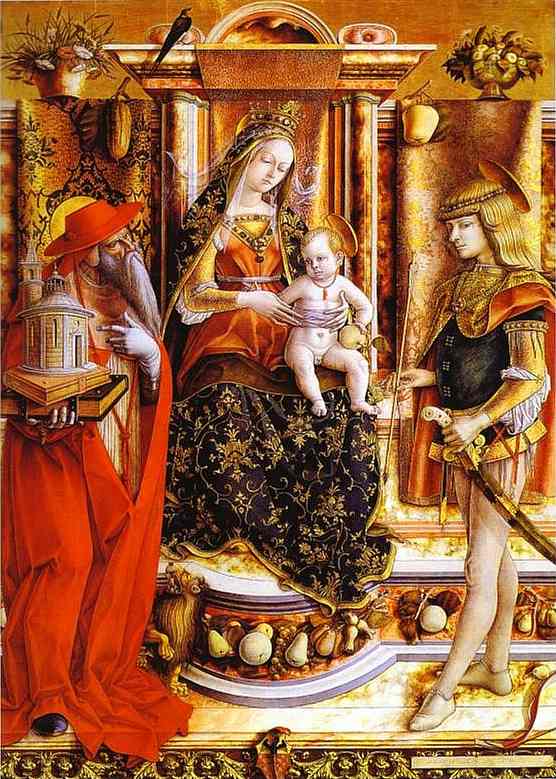
Madonna of the Swallow
Still wondering about a 15th century Italian painting in your family collection? Contact us…it could be by Carlo Crivelli.
Reviews
1,217 global ratings
5 Star
4 Star
3 Star
2 Star
1 Star
Your evaluation is very important to us. Thank you.
